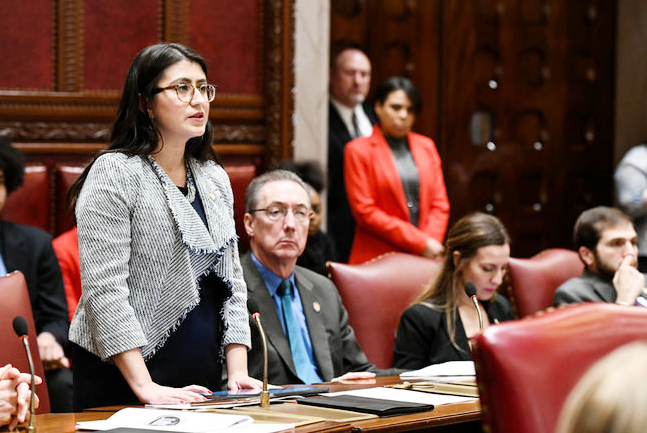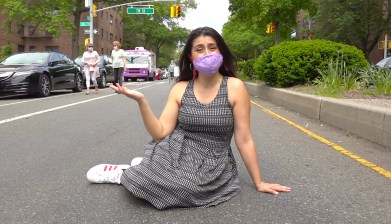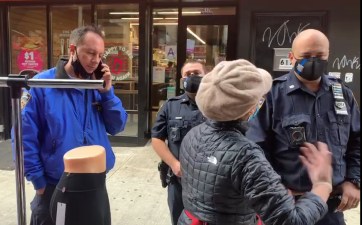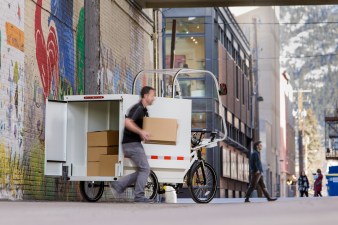Jessica Ramos’s Bill for More Food Vendors Just Split the #BikeNYC World

Relax, everyone — it’s not a “Falafel free-for-all,” as the New York Post called it.
But State Senator Jessica Ramos’s bill to eliminate local caps on the number of street vendors who can ply their trade — sometimes on already-narrow sidewalks — has riven the livable streets community just hours after the Tabloid of Record posted a story on the proposal.
“Please NO MORE food carts in NYC!! They clog our limited sidewalk space, bring more traffic into our streets, block bike lanes while loading and unloading,” tweeted Families for Safe Streets activist Melodie Bryant, starting a chain of responses on Twitter that suggested deep divisions among activists about the best way to encourage vending without having it overwhelm some places.
It didn’t take long for all the luminaries to weigh in:
I used to be a food cart vendor and I will fight for food carts! If we got the trash off our sidewalks and private vehicles off the curb, it wouldn’t even be an issue. Food carts are a big part of NYC way of life and have been for well over a century!
— Sarah Goodyear (@buttermilk1) November 4, 2019
Huh. I Hate their food which is greasy and smelly. But also more traffic, hauling of their cars around intersections, across bike lanes etc. Have no problem with the workers and believe they should have independent businesses, just not this one. And yes, Bklyn Br managed horribly
— @bikeloveny@bikeloveny.bsky.social (@bikeloveny) November 4, 2019
Food carts should have designated protected space on streets, not sidewalks. Should be able to attach to light posts for power with metered boxes, negating need for gas powered generators. @NYCComptroller @NYC_SBS
— Hilda (she/her) (@HildaBikes) November 4, 2019
Exactly
— @bikeloveny@bikeloveny.bsky.social (@bikeloveny) November 4, 2019
Sounds like Streetsblog needed to get Ramos on the phone immediately, which it did. The senator (and future gubernatorial candidate?) dispelled some myths right away: the bill, for example, would not necessarily create new vendors, but merely bring into compliance existing vendors.
“This has to do with sidewalk vendors and decriminalizing them and bringing them into the system,” she said. “Yes, it does away with caps, but it requires every street vendor to undergo the same process as the current legalized vendors” of which there are about 5,000.
“People who want to vend are already vending, whether they have a permit or not,” Ramos added, “so this is about legalizing those who are, which will protect consumers because the Department of Health, for example, will have inspected if it’s a food vendor. And so many of these vendors are people who are undocumented, so this would limit police interaction.”
Supporters of vendors have long championed the profession as a way for newcomers to make an honest living. But the livable streets community has had a love-hate relationship with all the additional street furniture that vendors represent. Ramos said there’s nothing in the bill (full text below) that prevents municipalities from restricting the location of vending in the name of public safety. And legalizing thousands more vendors would generate $70 million in sales taxes currently not being collected.
Yeah, but, parking?
“It will be up to every municipality to determine where it is safe for vendors to operate,” Ramos said. “Remember — I’m a pedestrian activist, too. My role as a state legislator is about figuring out how we can allow people to make an honest living and let the local legislatures in each city decide how to make that work for them.”
Ramos did admit that the Brooklyn Bridge pedestrian and cycling footpath is a disaster thanks to vendors — one that the city Department of Transportation refuses to fix.
“I walked the bridge just the other day and saw how the vendors leave very little room for pedestrians and cyclists,” she said. “And there were also four police vehicles blocking the pathway. But, as I said, the bill leaves that up to each city. I certainly empathize with the sentiment that it is difficult to walk or bike over the Brooklyn Bridge. But that’s the city’s responsibility. We need to rethink the way we use our streets.”
Jessica Ramos Vending Bill on Scribd



